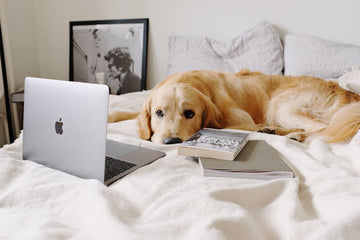Moving into an apartment with a dog may not be the easiest decision. Still, many pet owners choose apartment living for various reasons—work, convenience, or proximity to city amenities. While smaller square footage and the lack of a private outdoor space can make it challenging to meet your dog’s needs, it’s often the interactions with neighbors that can be the most intimidating aspect. From playful barks to howls when you’re away, your dog’s behavior can affect the people living nearby.
These are simply a few potential downsides to owning a dog in an apartment. But the good news is that you can manage these challenges through proper training, planning, and consideration for your neighbors. Solutions like grass pee pads for dogs can also help simplify apartment living by making bathroom breaks more convenient and preventing indoor accidents when outdoor access is limited. Being a responsible pet owner and a good neighbor starts with understanding and addressing your dog’s needs, ensuring they are well cared for and don’t disrupt the peace.
The Problems with Living with an Apartment Dog
According to the American Veterinary Medical Association, 44.5% of U.S. households own dogs in 2022. For many, dogs are not just pets but family members, making it difficult to leave them behind when moving to a new place. However, living in an apartment building can present unique challenges, particularly in densely populated complexes with no private yard.
Noise Complaints: Barking or whining can easily disturb neighbors, especially if your dog is left alone for long periods. Even dogs that don’t usually bark much may become more vocal in a confined space due to boredom, anxiety, or hearing other sounds in the apartment complex.
Smell and Cleanliness: A lack of regular outdoor access can lead to more frequent indoor accidents. Without regular cleaning and maintenance, your apartment can give off odors that drift into common areas, like hallways, which are unpleasant for neighbors. Cleaning up dog poop immediately is key to maintaining good relationships in the neighborhood.
Shared Spaces: Encounters in hallways, elevators, or lobbies can be stressful for dogs and neighbors. Unwanted behaviors like lunging, barking, or sniffing people without their consent can create awkward situations and even increase the risk of dog bites.
Restricted Outdoor Access: Limited access to outdoor spaces can result in fewer opportunities for exercise and bathroom breaks, leading to restless or unhealthy dogs. A dog that doesn’t get enough exercise is more likely to develop behavioral issues, from excessive barking to destructive chewing.
These are common problems for apartment dogs, but there are ways to overcome them and ensure your comfort.

7 Tips on Navigating Apartment Life with a Dog
As dog owners, maintaining a positive relationship with your neighbors and keeping your dog happy in an apartment requires planning and commitment. Here are some essential tips to make apartment living with your dog seamless and successful.
1. Be Honest About Having a Dog
Always disclose your pet to the landlord or property management before moving in. Sneaking in a pet can lead to a lack of access to amenities like dog parks and green areas. It may also leave you with no option but to avoid taking your dog outside for regular toilet breaks. This can negatively impact your dog’s potty training and well-being, leading to messy apartments and stressed neighbors.
2. Choose the Right Apartment
If possible, consider ground-floor units for easy access to outdoor areas. This reduces the need to navigate stairs or elevators and minimizes encounters with neighbors, which is particularly useful for shy or anxious dogs. Alternatively, look for apartments with balconies where you can set up a dog grass pee pad for bathroom breaks, making sure your dog has a convenient and accessible space for potty training when outside isn’t immediately accessible.
3. Create a Safe Space for Your Dog
Designate a specific area in your apartment where your dog can retreat and feel safe. This could be a cozy corner with a bed, blankets, and favorite toys. Consider crate training as well—having a dedicated dog home within your apartment helps reduce anxiety and gives your pet a sense of security. This space should be quiet, away from household traffic, and free from distractions.
4. Establish a Routine
Dogs thrive on routine, much like humans. Set a regular schedule for toilet breaks, meal times, and exercise. A consistent routine helps reduce anxiety and makes it easier for your dog to adjust to apartment living. Incorporate regular walks and potty breaks, ensuring your dog stays healthy and maintains good bathroom habits.
5. Prioritize Training
Proper training is essential to establish household rules and manage problematic behaviors. Focus on obedience training, crate training, and commands like “quiet,” which are necessary for minimizing noise and maintaining harmony with neighbors. A well-trained dog is less likely to engage in unwanted behaviors like excessive barking or jumping on people in shared spaces.
6. Exercise Accordingly
Different breeds have varying exercise needs. For example, high-energy breeds like Border Collies or Labradors need more physical activity than smaller breeds like Chihuahuas. Make sure your dog gets daily walks, indoor games, and, if possible, a high-intensity workout at least 1-2 times a week. Take your dog to a dog park to allow them to run off-leash and socialize, which helps prevent restlessness and boredom.
7. Clean Up Regularly
Dog odors, fur, and waste can make your apartment unpleasant for you and your neighbors. Clean frequently and use odor-neutralizing sprays or air purifiers. We recommend using Gotta Go Grass potty pads for indoor bathroom breaks. These renter-friendly solutions can help manage smells and keep your home cleaner. Always use dog waste bags when cleaning up after your pet outdoors, ensuring shared spaces stay clean for everyone.

Managing Barking and Noise
A well-rounded dog that has its needs met is less likely to engage in excessive barking. The tips above—regular exercise, training, and establishing a routine—can significantly reduce noise-related issues. Check out additional strategies to manage barking and maintain peace with your neighbors:
Avoid Leaving Windows Open: Open windows can provide distractions that trigger barking and present safety hazards. If your dog tends to bark at every passing car or dog outside, consider closing windows or using curtains to limit their view.
Limit Alone Time: Avoid leaving your dog alone for long periods, especially when adjusting to apartment life. Loneliness and separation anxiety can result in destructive behaviors and persistent barking. If you need to be away for extended periods, consider a dog walker or pet sitter to provide companionship and exercise.
Use Background Noise: Play soft music or leave the TV on to provide comforting background noise, masking external sounds that might cause your dog to bark. This is especially helpful for young or newly adopted dogs still getting used to their new environment.
Final Thoughts
As a dog owner living in an apartment, life doesn't have to be stressful. By being proactive, respecting your neighbors, and being intentional with meeting your dog's needs, you can create a positive living environment for everyone. Establish a routine, prioritize training, and manage your dog's behavior to ensure a harmonious apartment lifestyle with your furry family member. With the right approach, apartment dogs can thrive and remain beloved community members without causing disruptions.




